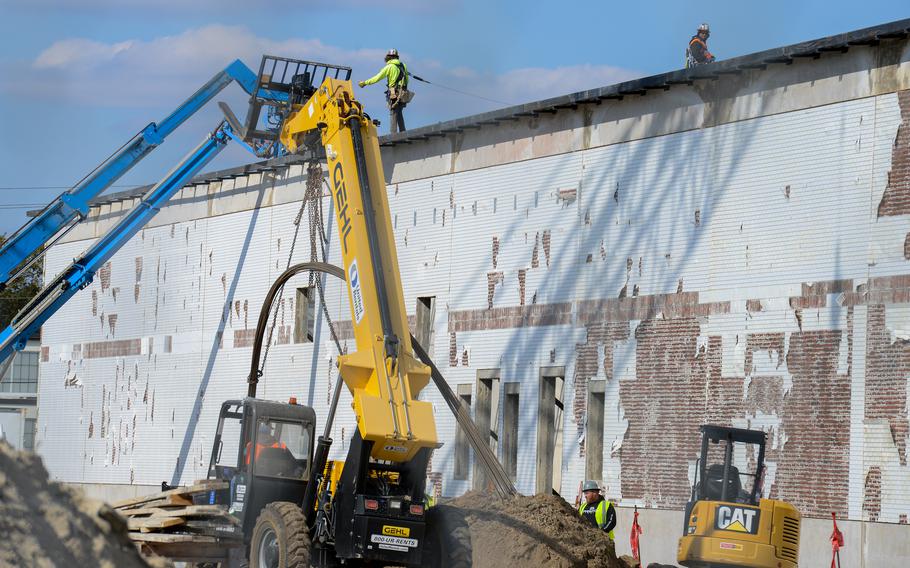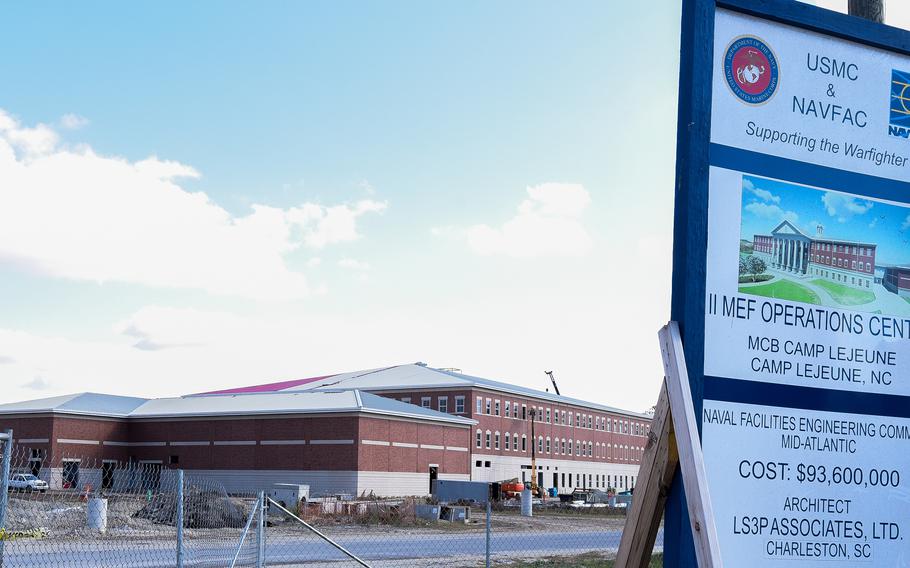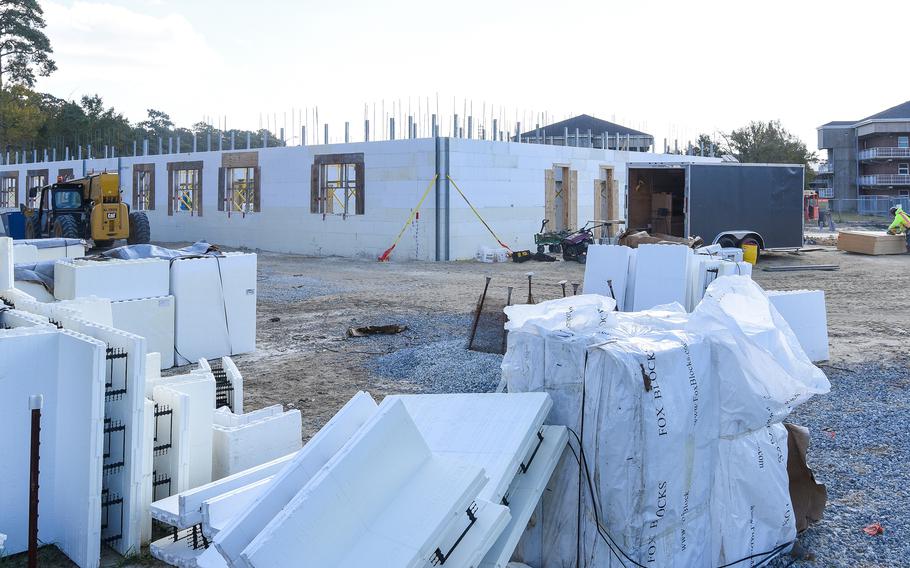.jpg/alternates/LANDSCAPE_910/XXXX%20LEJEUNE%20CONSTRUCTION%20photo%2004%202.jpg)
Construction workers demolish a former barracks building on Camp Lejeune, N.C., on Nov. 1, 2023. Dozens of construction projects are underway at the coastal North Carolina Marine base, including some $3.6 billion in renovations and new building projects authorized after Hurricane Florence caused major damage to the base in 2018. (Corey Dickstein/Stars and Stripes)
CAMP LEJEUNE, N.C. — Hundreds of buildings across the Marines’ sprawling Camp Lejeune sport shiny, new metal roofs — a feature that officials at the swampy, coastal North Carolina post said is key to ensuring they survive the devastating winds and waters future hurricanes could bring.
The concept is already proven, said Frank Orr, Camp Lejeune’s design branch director, who oversees renovation projects on the Marines’ premier East Coast installation. When Hurricane Florence crept along the North Carolina coast in September 2018, dumping a record 36 inches of rain in two days with wind gusts beyond 100 mph, Camp Lejeune buildings already outfitted with standing seam metal roofs went unharmed. However, hundreds of aging buildings — many dating back to the base’s earliest days in the 1940s — with more traditional, shingled roofs suffered catastrophic damage from the storm.
“Shingled roofs are just no good for this area,” Orr said Nov. 1 during a tour of dozens of construction sites that dot Camp Lejeune, where billions of dollars of construction continues more than five years after Florence walloped the base. Orr pointed out a newer development on the installation known as Wallace Creek, which was built in the early 2010s as Congress poured money into expanding military bases nationwide to house a growing force charged with fighting wars in Afghanistan and Iraq.
“These all have standing-seam metal roofs. Every one. And we didn’t have a roof leak, not a single one here [during Florence],” he said.
Now Orr and other installation officials overseeing dozens of construction and renovation projects across the 246 square-mile base are outfitting every new and revamped building with standing-seam metal roofs to protect against the next storm. But Camp Lejeune officials also warned that Florence’s impacts on the base’s older buildings revealed flaws with the military’s longstanding approach to its oldest buildings and infrastructure — conducting minor renovations at low cost instead of major overhauls, especially amid regularly shrinking or delayed budgets for renovations and new construction.

Construction sites dot Camp Lejeune five years after Hurricane Florence dropped record rainfall and flooding, and winds left some $3.6 billion in damage at the North Carolina base. (Corey Dickstein/Stars and Stripes)
“We’ve been doing cosmetic renovations throughout the years, but not a full [effort] to bring facilities up to date with more modern construction techniques,” Orr said. “[Hurricane Florence] really showed the weaknesses in these buildings, built up through 80 years, and how they can’t stand the test of time.
“Just putting on some lipstick and mascara over the years really hides the fact that these were broken buildings. Florence showed us we had quite a few broken buildings.”
Camp construction
Hurricane Florence made landfall at Wrightstville Beach in Wilmington, just south of Camp Lejeune, on Sept. 14, 2018, crawling across North Carolina’s coast and dumping record rain, high winds and producing massive storm surge that flooded the Marine base that sits along the waters of the Atlantic Ocean, the New River and Stones Bay.
When workers returned to the base days after the storm, they found streets still flooded and the roofs of older buildings left in tatters, Orr said. It took officials weeks to fully understand the extent of damage on the base, and even then, Orr said some of the devastation was not fully revealed until workers began tearing off old roofs and looking behind walls of impacted buildings.
Congress, in Florence’s wake, authorized some $3.6 billion to the installation for hundreds of renovations and to build about 40 new buildings in appropriations approved in 2019 and 2020. Years later, those projects continue, some nearing completion and others two or more years from being finished. Construction sites and building demolitions span the base, visible around nearly every turn on the installation.
That construction does not include repairs made to more than 3,000 homes on the base not owned by the Marine Corps, after more than half of the privatized family housing structures on post were damaged by Florence, according to the base.
Officials estimated about 90% of repairs to Marine Corps-owned buildings impacted by Hurricane Florence have been completed. Orr said about half of the Florence-related major renovations were completed and most of the other half of those projects were nearing completion. New builds have taken longer and have been slowed by supply chain issues related to the coronavirus pandemic and a shortage of local labor.
Marine Col. Adolfo Garcia, who oversees the base’s buildings and infrastructure as the commander of Marine Corps Installations East — Camp Lejeune, said he expects the new projects — and all Florence-related construction on base — to be completed by the end of 2025.
“Since Hurricane Florence impacted our communities, we are making tremendous progress on our installation recovery,” he said. “By the end of 2025, our installations will have buildings that are more resilient and more purpose-built to accommodate our Marines and sailors as they prepare to meet the global challenges of the 21st century.”
The Hurricane Florence construction does not account for all the projects across Camp Lejeune, where more than a dozen other buildings are also being built. But the storm’s impacts touch nearly every aspect of construction on the base, officials said.
Among them is a $93.6 million, 181,000 square-foot headquarters building for Camp Lejeune’s top unit, II Marine Expeditionary Force. Congress had funded that project before Hurricane Florence, but construction was sped up as the money to repair the installation poured in, said Sofia Schwartz, Camp Lejeune’s asset management branch director.
Schwartz said the new headquarters is badly needed on the post. II MEF and its 2nd Marine Division now share a headquarters building in a 1940s-era former hospital on the installation that suffered massive damage from Florence. That building was one of the most impacted by the storm, and it’s proven expensive to keep Marines working inside it ever since.

A new 181,000 square-foot headquarters building for Camp Lejeune’s II Marine Expeditionary Force, pictured on Nov. 1, 2023, is one of dozens of buildings under construction at the coastal North Carolina base. Construction has boomed on the base since Hurricane Florence dropped record rain in the installation wreaking havoc, especially on older buildings that were catastrophically damaged in the flooding. (Corey Dickstein/Stars and Stripes)
“The cost to replace the roof was significant,” she said. “The cost to continuously repair it on the inside is significant. And it’s an old hospital. It’s not designed for Marines to be working in.”
The old hospital will eventually be demolished, and 2nd Marine Division will move into a new headquarters building — a renovation of an existing building on Camp Lejeune with a new expansion.
The II MEF headquarters building is being built inland, as the base works to put new structures away from flood zones on the installation, when possible, Schwartz said. In some cases, workers are bringing in dirt to build new structures at higher ground levels, away from Camp Lejeune’s swamp grounds.
But those swampy areas might be increasing. Schwartz noted one construction project on the installation, in an area of Camp Lejeune known as Camp Johnson, in which officials had to scrap a project after they started building because of new wetlands on the post.
“When we started the building, we were going off older data, and when we did the site work investigations, we found the wetlands had grown,” she said. “Unfortunately, it was better to relocate that facility before construction than to try to build into that area.”
Modernizing old buildings
When the Navy purchased the land that would become Camp Lejeune in 1940, it was focused on ensuring Marines had a location to practice amphibious assault on the East Coast as the United States appeared likely to be pulled into World War II.
When the 1st Marine Division established its headquarters on that land and began constructing buildings, they likely did not expect those structures to remain in place nearly a century later or build them to withstand major hurricanes.
Today, Camp Lejeune is home to some 36,000 Marines and Navy sailors, who make up the II MEF — the headquarters that controls the Marines’ air, ground and logistics capabilities — and many of its subordinate units, including the 2nd Marine Division and 2nd Marine Logistics Group. The 2nd Marine Aircraft Wing is stationed nearby Camp Lejeune at Marine Corps Air Station Cherry Point, about an hour away but also in North Carolina. Camp Lejeune is also home to the 2nd Marine Raider Battalion.
The base remains a primary location for amphibious training, but it also trains new infantry Marines at its School of Infantry-East and provides home station training for all the troops stationed there.
For those current service members, Orr and Schwartz said, the base is working to maintain the traditional look and feel of those historic buildings, while ensuring their major renovation projects provide service members with state-of-the art facilities and the modern construction techniques meant to last for at least 30 years.

Construction sites dot Camp Lejeune five years after Hurricane Florence dropped record rainfall and flooding and winds left some $3.6 billion of damage at the North Carolina base. (Corey Dickstein/Stars and Stripes)
In most cases, the renovations have seen the old buildings nearly completely gutted, Orr said. In many cases, the exterior brickwork has been redone to modern standards that better allow for moisture intrusion to dry without damaging the structures.
But the most important part is the roofing — adding standing-seam metal roofs is the one thing officials can do to ensure the buildings hold up, Orr said, labeling them a “miracle product.”
Despite their resiliency, standing-seam metal roofs have some drawbacks — primarily expense. The process can cost about three times the amount of money of more traditional roofing materials. Orr argued that expense is worth every penny, especially because they come with 30-year warranties.
“Everybody talks about how expensive it is to build out here, but you’re getting something for that money,” he said. “We saw just how great the benefit was [during Florence], so all our Florence-related renovations and all our [new constructions] out here, all of them are being built with standing-seam metal roofs on them.”
The other element that will ensure the buildings being renovated and built on Camp Lejeune now hold up over decades is funding, Orr argued. Marine and Navy leaders and Congress must understand that buildings need more than facelifts to last, he said.
Aside from the Hurricane Florence-related money, Camp Lejeune’s facilities sustainment, restoration and modernization budgets have been underfunded for many years, Orr said. In a typical year, he has about $160 million in project needs, but only about an $80 million budget.
The result is projects get backed up, sometimes for years, and then when disaster strikes, buildings cannot hold up. It also impacts the base’s infrastructure. The installation is in the process of replacing some of its five decades-old underground infrastructure, including long-damaged storm drains, Orr said. But Camp Lejeune does not have enough money to complete all those infrastructure upgrades, pave roads and finish needed building renovations.
He said he would continue to fight for increased budgeting for such projects, but he understands Congress might instead pour money into the latest battlefield technology.
“I don’t necessarily know what the answer is there. These Marines have gotten used to living and working in good, not great, facilities, and you want to give these guys the best facilities you can to work and the best you can to support their mission,” Orr said. “But it’s a very limited pot [of funding].
“I get it. F-35s are great. They’re pretty awesome. I love an F-35, but you also see these guys struggling here day-to-day in some of these buildings they’re living and working in, so you’re trying to improve that — that costs money.”